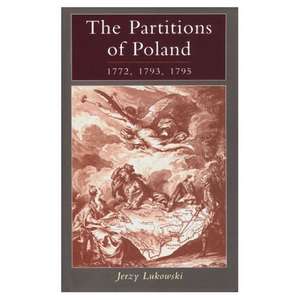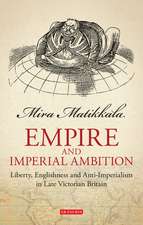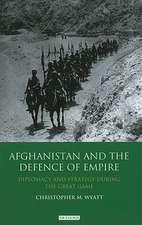The Partitions of Poland 1772, 1793, 1795
Autor Jerzy Lukowskien Limba Engleză Paperback – 4 ian 1999
| Toate formatele și edițiile | Preț | Express |
|---|---|---|
| Paperback (1) | 400.05 lei 3-5 săpt. | +15.90 lei 6-12 zile |
| Taylor & Francis – 4 ian 1999 | 400.05 lei 3-5 săpt. | +15.90 lei 6-12 zile |
| Hardback (1) | 764.20 lei 6-8 săpt. | |
| Taylor & Francis – 7 dec 2016 | 764.20 lei 6-8 săpt. |
Preț: 400.05 lei
Nou
Puncte Express: 600
Preț estimativ în valută:
76.55€ • 79.92$ • 63.35£
76.55€ • 79.92$ • 63.35£
Carte disponibilă
Livrare economică 14-28 martie
Livrare express 27 februarie-05 martie pentru 25.89 lei
Preluare comenzi: 021 569.72.76
Specificații
ISBN-13: 9780582292741
ISBN-10: 0582292743
Pagini: 248
Dimensiuni: 138 x 216 x 13 mm
Greutate: 0.28 kg
Ediția:1
Editura: Taylor & Francis
Colecția Routledge
Locul publicării:Oxford, United Kingdom
ISBN-10: 0582292743
Pagini: 248
Dimensiuni: 138 x 216 x 13 mm
Greutate: 0.28 kg
Ediția:1
Editura: Taylor & Francis
Colecția Routledge
Locul publicării:Oxford, United Kingdom
Public țintă
UndergraduateCuprins
Maps 1. Poland and Europe in the eighteenth century 2. The breakdown of Reform 3. The First Partition 4.Consent and settlement 5. Interlude 6. The Second Partition 7. The Third Partition Epilogue Appendix: Manuscript sources for parliamentary assemblies Bibliography Index
Descriere
The Partitions of Poland were a key event in the power politics of the late ancien regime, and had major long term consequences for the balance of power in northern and eastern Europe. Over a period of twenty five years Catherine II (Russia), Frederick II (Prussia) and Maria Theresa and Joseph II (Austria) between them wiped Poland xxx; Europe's second largest countryxxx; off the political map, and Poland disappeared as a state for 120 years. Jerzy Lukowski's new account, the first comprehensive study of the topic in English since 1915, sets the Polish dimension of this story in its wider European context, illuminating the motives and attitudes of the participants and exploring its consequences. This is a major contribution to the diplomatic history of eighteenth century Europe.















